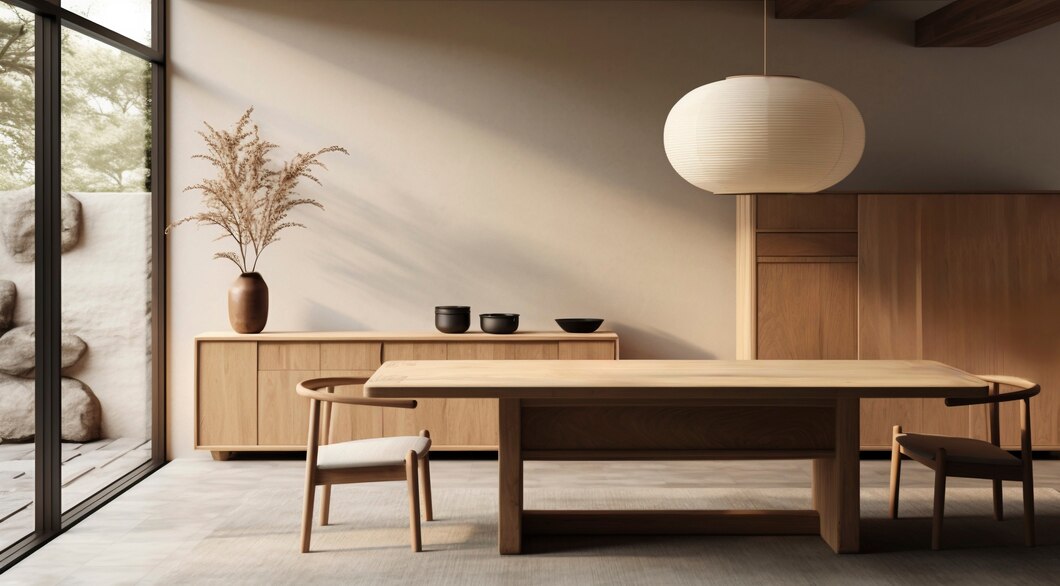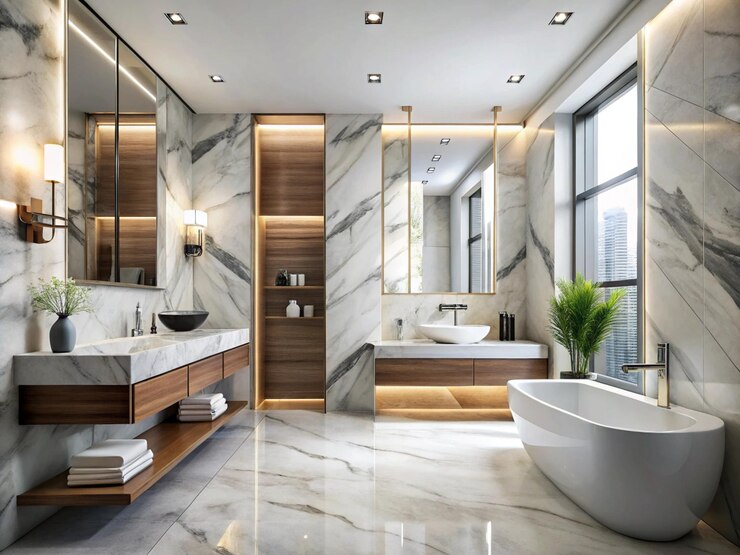Explore Japandi design in this comprehensive guide. Discover the blend of Japanese minimalism and Scandinavian functionality, its historical roots, defining features, and practical applications for modern interiors. Learn how Japandi promotes tranquility and sustainability in your living spaces.
Introduction
Japandi, an aesthetic that masterfully merges Japanese and Scandinavian design elements, has captivated interior design enthusiasts with its unique blend of simplicity and functionality. To understand Japandi, one must appreciate its origins in both Japanese and Scandinavian design philosophies, each of which carries a profound cultural heritage. Japanese interiors are renowned for their minimalism, a design principle rooted in Zen Buddhism that emphasizes tranquility and simplicity. Meanwhile, Scandinavian design is celebrated for its functionality and warmth, emerging from a tradition of practical yet aesthetically pleasing solutions to cold climates and long winters. By integrating these two distinct styles, Japandi creates a harmonious living environment that balances serene simplicity with functional elegance. This blog post delves into the intricacies of Japandi, exploring its historical roots, defining characteristics, and practical applications in modern interiors.
Historical Roots of Japandi
Japandi style is not merely a contemporary trend but rather a culmination of centuries-old design principles from both Japanese and Scandinavian cultures. The influence of Japanese aesthetics on Western design began to take shape in the late 19th and early 20th centuries, driven by increased international interaction and a fascination with Eastern philosophies. Concurrently, Scandinavian design evolved from a need for practical solutions in harsh climates, emphasizing simplicity and functionality. The convergence of these styles can be traced back to the early 20th century when designers from both cultures began to experiment with cross-cultural influences. This historical interplay laid the foundation for what we now recognize as Japandi. By understanding these historical contexts, one can better appreciate how Japandi encapsulates the essence of both traditions, creating a design language that is both timeless and contemporary.
Defining Characteristics of Japandi
At its core, Japandi is defined by a seamless blend of Japanese minimalism and Scandinavian functionality. The primary characteristics of Japandi include a neutral color palette, clean lines, and an emphasis on natural materials. Japanese design principles, such as Wabi-Sabi—the art of finding beauty in imperfection—meld with Scandinavian values of simplicity and warmth. This fusion results in interiors that are both visually calming and highly functional. Japandi spaces often feature a restrained use of decor, focusing instead on the quality and craftsmanship of each element. This approach not only enhances the aesthetic appeal but also promotes a sense of peace and well-being. The integration of natural materials, such as wood and stone, further emphasizes the connection to nature that is central to Japandi design. Through these defining characteristics, Japandi creates environments that are both aesthetically pleasing and deeply meaningful.
Practical Applications of Japandi in Modern Interiors
Implementing Japandi principles in modern interiors involves a careful selection of elements that reflect the style’s core values. When designing a Japandi space, one should prioritize functionality and simplicity, opting for furniture and decor that serve both practical and aesthetic purposes. For instance, choosing furniture with clean lines and natural finishes can help create a serene and uncluttered environment. Additionally, incorporating elements such as sliding shoji screens or low-profile furniture can enhance the Japanese influence while maintaining the Scandinavian emphasis on comfort and practicality. Lighting also plays a crucial role in Japandi interiors, with a focus on soft, ambient light that complements the natural materials and colors. By adhering to these practical guidelines, one can create a Japandi space that is not only visually harmonious but also conducive to a balanced and mindful lifestyle.
The Role of Natural Materials in Japandi Design
Natural materials are a cornerstone of Japandi design, reflecting the style’s deep connection to nature and its emphasis on sustainability. Wood, stone, and natural textiles are commonly used to create a warm and inviting atmosphere. In Japanese interiors, the use of natural materials often serves to blur the boundaries between indoor and outdoor spaces, fostering a sense of harmony with the natural environment. Similarly, Scandinavian design embraces the use of natural materials to bring warmth and texture to interiors. When combined in Japandi design, these materials create a cohesive aesthetic that is both soothing and enduring. The choice of materials is not only about visual appeal but also about enhancing the sensory experience of a space. By incorporating natural elements, Japandi design promotes a deeper appreciation of the natural world and contributes to a more sustainable and mindful approach to interior design.

Japandi and Minimalism: A Perfect Match
Minimalism is a key component of Japandi design, reflecting its roots in Japanese aesthetics and Scandinavian functionality. The minimalist approach emphasizes simplicity, focusing on the essential elements while eliminating excess. This principle is evident in the clean lines and uncluttered spaces characteristic of Japandi interiors. Minimalism in Japandi design goes beyond mere aesthetics; it also supports a lifestyle centered around mindfulness and intentional living. By reducing visual and physical clutter, Japandi promotes a sense of calm and order, encouraging a more thoughtful and deliberate approach to daily life. This alignment with minimalist principles not only enhances the visual appeal of a space but also contributes to a more balanced and harmonious living environment.
The Influence of Wabi-Sabi on Japandi
Wabi-Sabi, the Japanese philosophy of embracing imperfection and transience, plays a significant role in Japandi design. This concept celebrates the beauty of natural imperfections and the passage of time, offering a counterpoint to the often sterile and uniform aesthetics of contemporary design. In Japandi interiors, Wabi-Sabi manifests through the use of handmade and artisanal elements, as well as the incorporation of natural materials with unique textures and finishes. This influence encourages a more authentic and personal approach to design, where the character and history of each element are valued. By embracing Wabi-Sabi principles, Japandi creates spaces that are not only visually appealing but also rich in meaning and depth.
Japandi and Sustainability: A Symbiotic Relationship
Sustainability is an inherent aspect of Japandi design, reflecting the values of both Japanese and Scandinavian cultures. Both traditions emphasize a deep respect for nature and a commitment to environmental stewardship. In Japandi design, sustainability is achieved through the use of natural and eco-friendly materials, as well as a focus on quality and longevity. The minimalist approach of Japandi also supports sustainability by reducing waste and encouraging the thoughtful selection of each element. By integrating sustainable practices into Japandi design, one can create interiors that are not only beautiful and functional but also aligned with broader environmental goals. This symbiotic relationship between Japandi and sustainability underscores the style’s relevance in contemporary design and its potential to contribute to a more sustainable future.
Japandi in Different Spaces: Residential, Commercial, and Beyond
Japandi design is versatile and can be adapted to various types of spaces, including residential, commercial, and public environments. In residential settings, Japandi creates serene and functional living spaces that promote relaxation and well-being. The style’s emphasis on simplicity and natural materials makes it ideal for creating cozy and inviting homes. In commercial settings, Japandi can enhance the ambiance of offices, retail spaces, and hospitality venues, offering a refined and professional aesthetic that fosters productivity and comfort. Public spaces, such as libraries and community centers, can also benefit from Japandi’s calming and inclusive design principles. By adapting Japandi to different contexts, one can leverage its unique attributes to create environments that are both aesthetically pleasing and functionally effective.
Creating a Japandi-Inspired Home: Tips and Ideas
Designing a Japandi-inspired home involves careful consideration of both aesthetic and functional elements. To achieve the Japandi look, start by selecting a neutral color palette that includes shades of white, beige, and gray. Choose furniture and decor with clean lines and natural finishes, avoiding excessive ornamentation. Incorporate natural materials, such as wood, stone, and linen, to create a warm and inviting atmosphere. Lighting is also crucial in Japandi design; opt for soft, ambient lighting that complements the natural materials and enhances the overall mood of the space. Additionally, focus on creating a sense of balance and harmony by arranging furniture and decor in a way that promotes flow and tranquility. By following these tips, one can successfully incorporate Japandi principles into their home, resulting in a space that is both beautiful and functional.
Japandi and the Concept of Hygge
The concept of hygge, which originated in Denmark, shares similarities with Japandi design, particularly in its emphasis on comfort and well-being. Hygge refers to the practice of creating a cozy and pleasant atmosphere, often through the use of simple and natural elements. In Japandi design, the principles of hygge are reflected in the use of soft textures, warm materials, and a focus on creating a welcoming and relaxing environment. Both Japandi and hygge prioritize a sense of contentment and emotional well-being, making them complementary design philosophies. By integrating elements of hygge into Japandi interiors, one can enhance the overall comfort and coziness of the space, creating a more harmonious and enjoyable living environment.
Japandi and Functional Design
Functional design is a fundamental aspect of Japandi, reflecting the Scandinavian emphasis on practicality and efficiency. In Japandi interiors, every element serves a purpose, contributing to the overall functionality of the space. This approach ensures that spaces are not only visually appealing but also highly practical and easy to navigate. When designing a Japandi space, consider incorporating multi-functional furniture, such as storage ottomans or extendable tables, to maximize utility. Additionally, prioritize ergonomic design and efficient use of space to enhance comfort and convenience. By focusing on functional design, Japandi creates environments that support a balanced and efficient lifestyle, while also maintaining a sense of aesthetic harmony.

Incorporating Japandi Elements into Existing Spaces
Incorporating Japandi elements into existing spaces can be a rewarding way to refresh and enhance one’s home. Start by introducing key Japandi features, such as natural materials, neutral colors, and minimalist furniture, to create a cohesive look. Consider replacing or updating existing decor items with pieces that reflect Japandi principles, such as simple, handcrafted objects or high-quality textiles. Additionally, rearrange furniture and decor to promote a sense of balance and flow, taking care to create uncluttered and harmonious spaces. Small changes, such as adding a Japanese-style sliding screen or a Scandinavian-inspired rug, can also make a significant impact. By integrating Japandi elements thoughtfully, one can transform their space into a serene and stylish environment that reflects the best of both design traditions.
The Future of Japandi Design
The future of Japandi design is poised to continue evolving as it responds to changing trends and new influences. As the demand for sustainable and mindful design practices grows, Japandi is well-positioned to remain relevant, given its inherent focus on natural materials and functional aesthetics. Future developments in Japandi design may include the integration of new technologies and innovative materials that align with its principles of simplicity and sustainability. Additionally, as global design trends continue to intersect, Japandi may continue to evolve and incorporate elements from other cultural influences. The ongoing relevance of Japandi will likely be shaped by its ability to adapt while staying true to its core values of tranquility, functionality, and harmony.
Japandi in Popular Culture
Japandi design has made significant inroads into popular culture, influencing everything from interior design magazines to social media platforms. The style’s emphasis on simplicity and elegance has resonated with a broad audience, leading to its widespread adoption and adaptation. Influencers and design bloggers frequently showcase Japandi-inspired spaces, highlighting its appeal and versatility. Additionally, Japandi design has been featured in various media, including television shows and design competitions, further cementing its place in contemporary culture. By examining its presence in popular culture, one can gain insight into the factors contributing to Japandi’s growing popularity and its impact on modern design trends.
Personalizing Japandi Spaces
Personalizing Japandi spaces involves incorporating individual preferences and unique elements while maintaining the style’s core principles. To personalize a Japandi interior, consider adding personal artwork, cherished objects, or custom-designed pieces that reflect one’s personality and tastes. Additionally, incorporate elements that evoke personal memories or cultural significance, creating a space that feels truly unique and meaningful. While personalization is important, it should be balanced with Japandi’s emphasis on simplicity and functionality. By thoughtfully integrating personal touches, one can enhance the overall character and warmth of the space while staying true to Japandi’s design philosophy.
Japandi and Wellness
Japandi design has a profound impact on wellness, reflecting its emphasis on tranquility and balance. The minimalist approach and use of natural materials contribute to a calming and harmonious environment, which can positively affect mental and emotional well-being. Japandi spaces often promote a sense of peace and relaxation, encouraging mindfulness and a deeper connection to one’s surroundings. Additionally, the focus on functional design supports a healthier and more organized lifestyle, reducing stress and enhancing daily living. By prioritizing wellness in Japandi design, one can create spaces that not only look beautiful but also support overall health and well-being.
Japandi and Seasonal Changes
Japandi design adapts gracefully to seasonal changes, reflecting its inherent flexibility and relevance throughout the year. Seasonal variations can be incorporated through the use of different materials, colors, and textures that align with the changing environment. For example, during colder months, one might introduce warmer textiles, such as wool throws or plush rugs, to enhance comfort and coziness. In contrast, lighter materials and fresh colors can be used during warmer seasons to create a more airy and vibrant atmosphere. By embracing seasonal changes, Japandi design remains dynamic and adaptable, offering a timeless aesthetic that evolves with the changing seasons.

Japandi and Space Planning
Effective space planning is crucial in Japandi design, as it helps to create functional and harmonious interiors. The minimalist approach emphasizes the importance of thoughtful arrangement and efficient use of space, ensuring that each element serves a purpose and contributes to the overall design. When planning a Japandi space, consider the flow and balance of the room, as well as the placement of furniture and decor items. Incorporate multifunctional pieces and storage solutions to maximize utility and reduce clutter. By focusing on space planning, Japandi design creates environments that are not only visually appealing but also highly practical and comfortable.
The Influence of Japandi on Contemporary Design Trends
Japandi design has influenced contemporary design trends, shaping the way designers and homeowners approach interior aesthetics. The style’s emphasis on simplicity, functionality, and natural materials has inspired new approaches to design, incorporating elements of Japandi into a variety of contexts. From modern residential interiors to innovative commercial spaces, Japandi principles are being adapted and integrated into diverse design practices. This influence is evident in the growing popularity of minimalist and sustainable design trends, which reflect Japandi’s core values. By examining Japandi’s impact on contemporary design, one can gain insight into the broader trends shaping the future of interior design.
Conclusion
Japandi design represents a sophisticated and harmonious fusion of Japanese and Scandinavian aesthetics, offering a unique approach to modern interiors. Its emphasis on minimalism, functionality, and natural materials creates spaces that are both visually calming and highly practical. By understanding the historical roots, defining characteristics, and practical applications of Japandi, one can fully appreciate the depth and beauty of this design style. Whether incorporating Japandi elements into existing spaces or embarking on a new design project, the principles of Japandi offer a timeless and enduring approach to creating serene and functional living environments.





